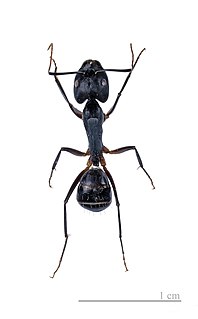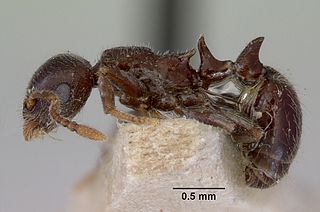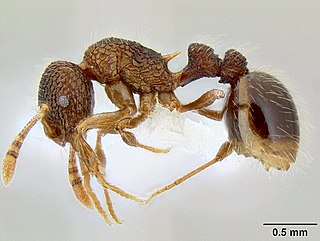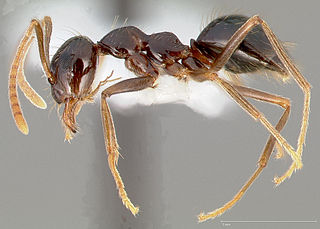
The Formicinae are a subfamily within the Formicidae containing ants of moderate evolutionary development.

Leptomyrmex, or spider ants, is a genus of ants and a distinctive member of the ant subfamily Dolichoderinae. Commonly known as "spider ants" for their long legs and spider-like movements, these orange and black ants are prominent residents of intact wet forest and sclerophyll habitats throughout their range. One extant species, Leptomyrmex relictus, is known from central Brazil; otherwise, the global distribution of this genus is restricted to eastern Australia, New Caledonia and New Guinea, as well as the nearby Indonesian islands of Aru and Seram.

Diacamma is a genus of queenless ants sometimes known as Asian bullet ants, belonging to the subfamily Ponerinae. It is distributed from India to Australia and contains about 24 species.

Myrmecina is a genus of ants in the subfamily Myrmicinae. It contains 51 species distributed in North America, Europe, northern Africa, India east, Korea, Japan and Australia.

Peronomyrmex is a rare genus of ants in the subfamily Myrmicinae. Its three species are known from the east coast of Australia. With only five specimens in total, collected from four localities, Peronomyrmex is one of the world's most rare ant genera.

Calyptomyrmex is a genus of ants in the subfamily Myrmicinae. The genus is distributed from Africa to India and east to New Caledonia. They are mainly found in the rainforest, where they forage alone or in small numbers.

Austromorium is an Australian genus of ants in the subfamily Myrmicinae. The genus contains two species, one of which, Austromorium flavigaster, is fairly common and widespread in southern Australia. The other species, Austromorium hetericki, is only found in Western Australia. Little is known about their biology.

Paraparatrechina is a genus of small ants in the subfamily Formicinae. The genus contains 31 species distributed in the tropics of Africa, Asia and Australia.

Calomyrmex is a genus of ants in the subfamily Formicinae. The genus is known from Indonesia, New Guinea and Australia. Calomyrmex has a mandibular gland that secrets red droplets on the sides of its head that have a strong and unpleasant odor when disturbed.

Teratomyrmex is a genus of ants in the subfamily Formicinae. The genus is known only from forested areas on the east coast of Australia.

Myrmecorhynchus is a genus of ants in the subfamily Formicinae. The genus is endemic to Australia, where its species are found in forested areas. They nest in soil or on trees or shrubs.

Notoncus is an Australian genus of ants in the subfamily Formicinae. The genus is known from Australia, where the ants nest in the soil or on the ground under stones and logs in forested areas. The ants are also common in gardens and parks.

Prenolepis is a genus of ants in the subfamily Formicinae. Most species are found in southeastern Asia and southern China, but the genus has a wide distribution with species known from North America, southern Europe, Anatolia, Cuba, Haiti, and West Africa.

Buniapone is a monotypic genus of ants in the subfamily Ponerinae. Buniapone amblyops, the single described species, is found in Southern and Southeast Asia.
Dolichoderus albamaculus is a species of ant in the genus Dolichoderus. Described by Shattuck and Marsden in 2013, the species is widespread in arid regions of Australia, being found in many various habitats.
Dolichoderus gordoni is a species of ant in the genus Dolichoderus. Described by Shattuck and Marsden in 2013, the species is only known from southern Queensland in Australia, mainly around forested areas.
Dolichoderus inferus is a species of ant in the genus Dolichoderus. Described by Shattuck and Marsden in 2013, the species is endemic to Australia, where it inhabits both wet and dry sclerophyll habitats and forages on low vegetation and trees.
Dolichoderus kathae is a species of ant in the genus Dolichoderus. Described by Shattuck and Marsden in 2013, the species is endemic to semi-arid regions in South Australia.
Dolichoderus semiorbis is a species of ant in Dolichoderus. Described by Shattuck and Marsden in 2013, the species is endemic to Australia.














